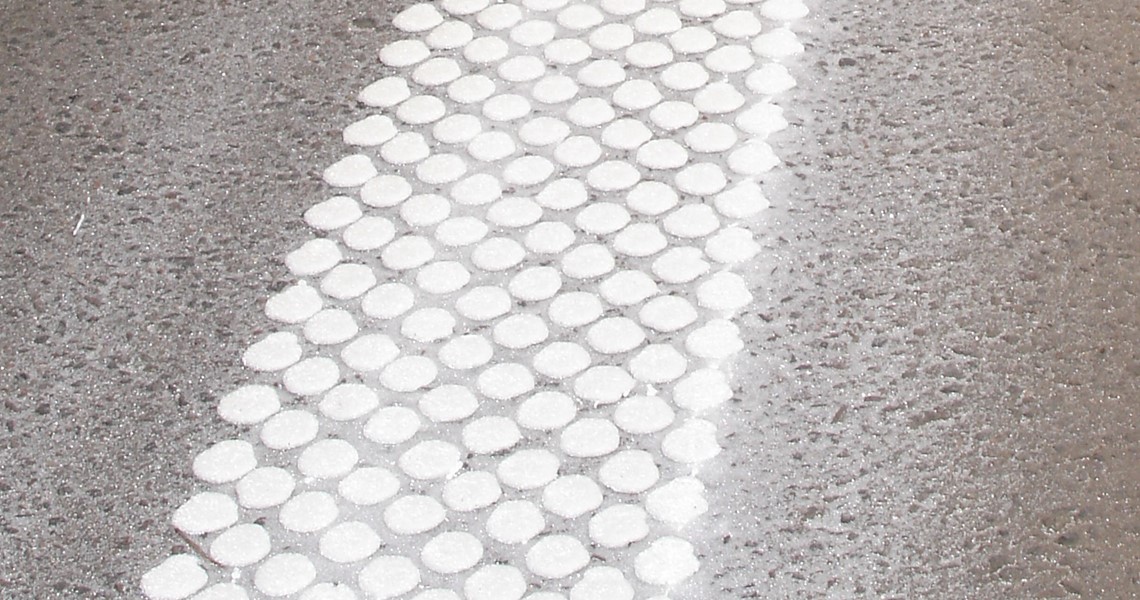Editorial for World Highways, September the 20 th 2006 / Mads Høy Mortensen
New innovations from Borum The “Dot’n line” and a cruise control system: New phenomena which Borum customers will benefit from in the 2007 season and onwards. Improved road marking quality and superior night retro-reflection are the results of these new solutions.
High reflection technology Good visibility is essential for road safety. Among the many parameters, which influence the visibility, a key parameter is retro reflection. This can be obtained by using modern road marking techniques, which is a very effective and relatively inexpensive way to guide the traffic. Road marking has developed rapidly since the mid 80ties e.g. with the use of glass beads to improve retro-reflection at night. However, other technologies have also been taken in use to ensure safety during all weather conditions night and day.
Today road marking is divided into two main types:
Type 1, the traditional road marking without profiles or surface topology. This type can also be scattered with glass beads to improve night visibility. However, Type 1 road marking has limitations even with glass beads scattered on the surface. In wet conditions a water film is building up on the road marking reducing the retro-reflection significantly.
Type 2, which is the newest road marking technology where parts of the road marking topology is raised over the road surface. This has the important advantage to ensure a perfect retro-reflection especially during night. Furthermore, Type 2 road marking systems can be scattered with glass beads to improve the retro-reflection.
Dot’n line – improving road safety The Borum answer to a cost effective solution on a modern Type 2 marking is Dot’n line. Borum has with this patented solution set the new standard in the industry making it possible to fulfil the marking requirements set by road authorities worldwide. The Dot’n line machine is a flexible modern road marking “factory on wheels” operating at an industrial scale, with a speed of more than 10 km/h during marking.
The Dot’n line technology is very versatile and offers the user a three-in-one solution:
- Base line (flat lines)
- Agglomerate (randomized surface topology – profiled pattern)
- Unique combinations of base line with agglomerates

DSGS trial marking in the Harz, Germany Through Borum’s membership of the German Road Marking Association (DSGS) the company was – among others companies – invited to participate in a trial marking at the B4 highway in the Harz region in Germany. The trial was carried out on August the16 th 2006 with the Dot’n line installed on a Borum Highway machine – this was the first official launch of the Dot’n line technology.
Borum made two trials – both Type 2 markings
- Agglomerate (dots) alone (test field 90)
- A combination of a base line with agglomerate (test field 89)


Each test field consisted of eight parallel lines 2 meters long with a width of 15 cm. DSGS is measuring the results and will over the next two years measure the degradation of the road marking four times. The updated results will be displayed on the Borum web site: www.borum.as
Extraordinary results The first trial results, measured by DSGS, are looking very promising. As seen in table 1 the results are well over the generally accepted “best practice” values.
The day reflection of the combined line is somewhat better than the Agglomerate alone. When looking at the retro-reflection at night the Agglomerate marking alone is better than the combined line. The reason is the larger perpendicular surfaces on the Agglomerate marking – the dots are higher and reflect the light back towards the driver (retro–reflection).
A combination marking consisting of a base line with agglomerate is the optimal compromise, giving a retro-reflection (night), which is well over the best practice value. At the same time this marking type has superior day reflection capabilities. Another important issue regarding the choice of road marking type is the legislation. Several European countries are aiming at allowing only combination lines. The Dot’n line is therefore a secure investment for marking companies aiming at staying in front
To be continued
The Dot’n line equipment has been tried out on the road by marking companies for the last couple of years and the equipment is found both very durable and highly reliable in the daily service by the users. Further full scale trials are planned in Denmark during the fall 2006 making the Dot’n line applicator ready for commercial use by Borum customers early 2007. The overall goal for Borum is to produce the optimal combination line with both superior day and night reflection, and thereby contributing to improved traffic safety.
Launch of a world novelty
As the first road marking machines in the world the Borum Highway and Motorway series are now equipped with the newly developed “cruise control system”. When developing this new feature Borum was inspired by the automotive industry where premium segment cars are equipped with such technology.
The equipment provides several advantages for the operator and thereby also for the marking result on the road. With the automatic cruise control activated the operator is relieved from the task of controlling the speed manually and is able to concentrate on steering the machine and optimizing the visual appearance of the road marking. Use of the system will provides a better working environment for the operator and furthermore leads to a reduction of fuel consumption.
Besides the advantages mentioned above the quality of the road marking will be more homogenous (straightness, uniformity and thickness) over the distance covered. The cruise control is active from virtually zero km/h and is operational in the entire speed range.
If you are interested in more information or perhaps a demonstration please feel free to contact Borum with your enquiry.